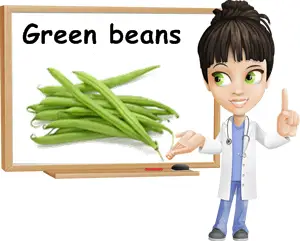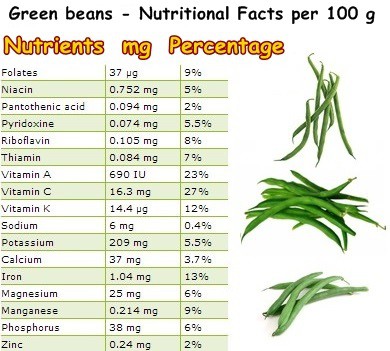Green beans or string beans are among the most versatile vegetables in the world. They can be boiled, steamed, fried, grilled, used in casseroles, soups, salads or pasta. They are a great source of vitamins A, C and K and important dietary minerals with tonic and restorative effects. They are available fresh, canned, frozen and you can successfully grow them in your home garden. They are also quite a figure-friendly vegetable, low in calories and high in dietary fiber to lower our fats absorption.
Regular consumption contributes to better vision and improves immunity as a result of the vitamin A and vitamin C content of the beans. Moreover, eating green beans helps prevent hemorrhage and easy bruising and contributes to good energy levels. The vegetable contributes to regulating intestinal transit, preventing anemia and improving blood pressure. Even children are unlikely to refuse them, which is great news seen that they boast so many health benefits.

Green beans or string beans are in fact common beans (scientifically known as Phaseolus vulgaris) that have not yet reached maturity. They are usually picked as soon as they turn green because that’s when they are tenderest and easiest to cook. Let me tell you a secret: if you feel green beans are a bit stringy, then they are too old. Generally, green beans are low in calories, approximately 31 kcal/100 g (131 kcal/100 g), and they don’t have any saturated fats.
In addition to this, they have numerous vitamins, minerals as well as important phytochemicals.
What are green peas good for
Most importantly, green beans are a rich source of dietary fiber which helps keep our colon healthy by reducing its exposure to waste (or by regulating bowel movements). Moreover, dietary fiber is important because it helps lower blood cholesterol levels by reducing the amount of fats our intestines absorb following digestion.
As always, moderation is the key, so make sure you have a reasonable intake of fiber as dietary fiber also binds to the nutrients from food, reducing our vitamin and minerals intake as well and exposing us to the risk of developing nutrient deficiencies.
Aside from this, green beans are rich in vitamin A and an excellent source of flavonoids and lutein, natural compounds with antioxidant and anti-inflammatory effects. Actually, the vitamin A in plant foods such as green beans is not the same as the vitamin A in liver, meat, butter and other animal products. Green beans don’t have pre-formed vitamin A, but rather precursors of the vitamin in the form of carotenoids – pigmented antioxidants with vitamin A activity.
Carotenoids have antioxidant, anti-inflammatory, anti-aging and reparative properties. Furthermore, the carotenoid antioxidants in green beans, mostly beta-carotene, but also lutein contribute to better eyesight and protect the retina from radiation from sunlight and subsequent free radical damage.

Above, you will find the nutritional value for 100 g of green beans. As you can see, green beans are an excellent source of folic acid. Folic acid and vitamin B12 are essential components in the process of DNA synthesis and cell division. Moreover, folic acid is crucial during pregnancy because it prevents a series of birth defects called neural tube defects that affect the brain and the spinal cord.
Green beans also have vitamin B6, thiamine (or vitamin B1) and vitamin C. As you may already know, vitamin C boosts your immune system and is the biggest ally in the fight against the infamous free radicals. Ladies, pay attention: vitamin C is essential for the production of collagen, the structural protein which is responsible for the elasticity and overall youthful appearance of the skin.
In addition to this, green beans contain minerals such as iron, calcium, magnesium, potassium and manganese. Manganese is a mineral that plays a key-role in the fight against free radicals. Potassium maintains our body’s regular fluid levels and regulates our blood pressure by neutralizing the effects of an exaggerated sodium intake. It also helps prevent water retention and its side effects: face puffiness or puffiness under the eyes, abdominal bloating, swollen legs, ankles or feet.
See also : Can You Eat Raw Green Beans?

List of health benefits of Green Beans
Here are the top 11 health benefits associated with consumption of green beans:
- Low in calories, promotes weight loss.
- Source of fiber for healthier blood cholesterol levels.
- Great food to eat for constipation and hemorrhoids.
- Contain vitamin A for good vision and a strong immune system.
- Source of folic acid for pregnant women.
- Source of antioxidants such as manganese, vitamins A and C.
- Good for anemia and fatigue thanks to a great iron content.
- Energizing and restorative thanks to B vitamins and iron.
- Anti-inflammatory action as a result of vitamins C and K.
- Good for skin and hair health thanks to a varied B vitamin profile.
- Benefits for water retention and bone health.
Conclusion
Something you might find interesting: you may refer to green beans both as vegetables and legumes. Legume refers to Leguminosae (or Fabaceae), a family of plants whose fruits are enclosed within a pod. But since legumes are vegetables, green beans are both vegetables and legumes. All things considered, they are not a only nutritious and healthy food, but also a delicious option. There are virtually no side effects associated with reasonable intake, so including green beans into your diet can both add variety and contribute to nutritional status.
